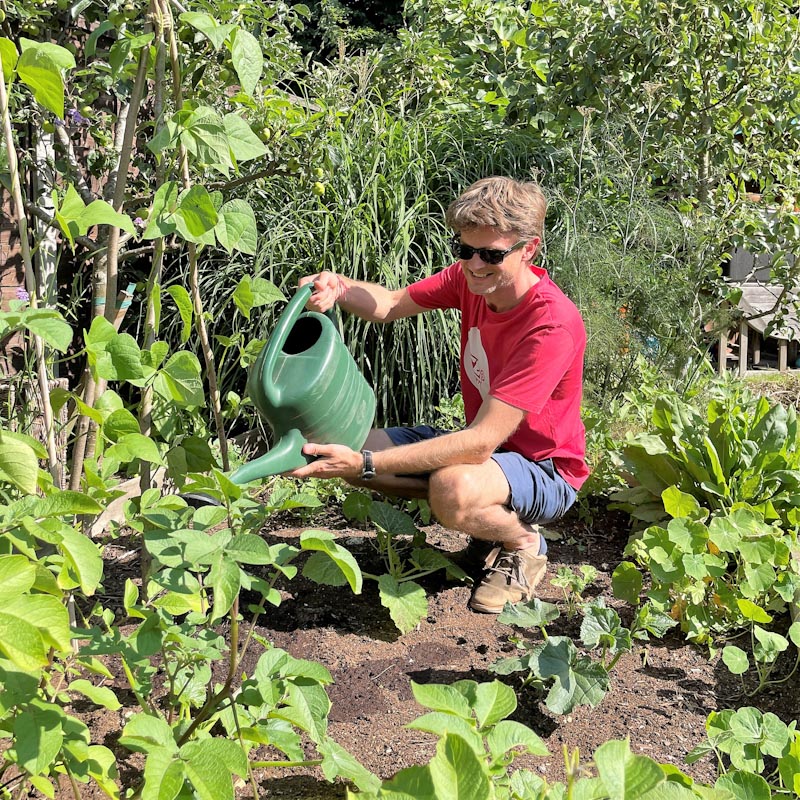Water is vital for plant life, but how much to give and when? Here’s our handy guide to effective watering.

Are my plants getting enough water?
Getting to know your plants is key! They’ll tell you when they’re happy and when they’re not, so look out for the following signs of a thirsty plant;
- Less than expected production of foliage, fruits or flowers.
- Leaves or stems that look dull, or are darker or even paler than usual.
- Changes in leaf direction, they may droop downwards or start to curl at the edges.
- Wilting, the leaves may turn brown and crispy in extreme cases.
- Pots are lighter than usual, maybe they’re even blowing over in the wind?
- Signs of powdery mildew (a white coating on leaves, stems and flowers).
Note: Be careful not to overwater, too much love can cause plant leaves to wilt or droop also when overwatered! – a balance is needed.
When should I water?
You may have heard that watering in the mid-day sun can cause the leaves to scorch. Even on the sunniest of days this is no more than a myth! Watering during the middle of the day will still be welcomed by any thirsty plant but is less efficient; more moisture will be lost to evaporation and strong winds are more common.
The best time to water is in the morning and will give your plants a good store of water to get through the days heat. Watering in the cooler evenings will also mean less water is lost to evaporation, however the surface of the soil and foliage will remain damp for longer which can encourage slugs and snails, and the plants may be more susceptible to fungal diseases.
It’s best to keep the soil damp, not wet! Roots need air in order for the plant to grow well.
It’s better to water thoroughly every now and again than it is to water lightly and frequently. By giving them a good soaking low down at the base of the plant (not all over the leaves) the water will get into the deeper soil where it’s needed by the root tips. Light watering can encourage the plants to grow roots closer to the soil’s surface make them more susceptible to drought.
How much water should I give my plants?
Plant Type How much water to give your plants depends on the requirements of individual plants; shade-loving plants and those from cooler, damper, climates will be less adapted to hot and dry weather so will need more water than sun lovers such as alpine plants. Those plants that are actively growing will also need more frequent watering than those that are dormant.
Soil Type If your soil is sandy or chalky you’ll need to water more frequently than soil with a high clay content as they’ll retain less moisture. You can water less heavily than you would need to for clay soil as any excess will drain freely.
Top tip
Digging organic matter into your soil will help it to retain more moisture.
Containers If your plants are in pots, the roots will be drinking any moisture from a smaller soil volume than if they were growing freely in the ground. The soil will dry out more quickly and will need watering more frequently. Try putting potted plants in shade to reduce water loss through evaporation, or water once or twice a day if in full sun and your plants are less drought tolerant.
Soil Dampness Water is absorbed by the root tips so don’t go by the dryness of the soil’s surface as a marker for when to water. Push a finger into the compost to knuckle depth; if the soil is damp you’re OK, if it’s dry, water.
Watering and caring for your plants is a lovely therapeutic activity, so enjoy.
The Seed Pantry team 🌼
#SeedPantryGrowClub
WIN a lucky-dip addition to your next box by sharing your plant pictures with us on Instagram. Use the hashtag #SeedPantryGrowClub or tag us @seedpantry to enter.
Subscribe to the Grow Club box for flowers, food and herb seeds ready to sow each month… Curious? Come check out all of this month’s options!
